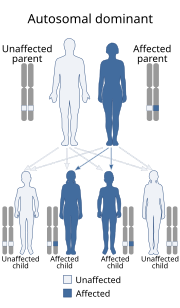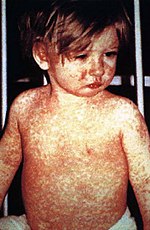now known as the Apert syndrome subtype of acrocephalosyndactyly. Other subtypes of acrocephalosyndactyly were characterized throughout the 20th century...
30 KB (2,746 words) - 02:29, 7 July 2024
Apert syndrome (redirect from Acrocephalosyndactyly (Apert))
Apert syndrome is a form of acrocephalosyndactyly, a congenital disorder characterized by malformations of the skull, face, hands and feet. It is classified...
21 KB (2,523 words) - 13:23, 21 June 2024
Pfeiffer syndrome (redirect from Acrocephalosyndactyly, type V)
Pfeiffer syndrome is a rare genetic disorder, characterized by the premature fusion of certain bones of the skull (craniosynostosis), which affects the...
14 KB (1,444 words) - 19:55, 23 August 2024
syndactyly, and polydactyly. Acrocephalopolysyndactyly is a variation of acrocephalosyndactyly that presents with polydactyly. It was first characterized in 1909...
14 KB (1,690 words) - 02:01, 30 October 2024
Saethre–Chotzen syndrome (redirect from Acrocephalosyndactyly type 3)
Saethre–Chotzen syndrome (SCS), also known as acrocephalosyndactyly type III, is a rare congenital disorder associated with craniosynostosis (premature...
29 KB (2,854 words) - 08:40, 18 April 2024
turricephaly include: Achondrogenesis, type IA Acrocephalopolydactyly Acrocephalosyndactyly type V (Goodman syndrome) Acrocraniofacial dysostosis Alopecia -...
7 KB (406 words) - 03:32, 30 July 2024
following conditions feature exophthalmos: 4p partial monosomy syndrome Acrocephalosyndactyly type I Acrofrontofacionasal dysostosis type 2 Aneurysm-osteoarthritis...
11 KB (1,097 words) - 03:17, 9 August 2024
Jackson–Weiss syndrome (redirect from Acrocephalosyndactyly Jackson Weiss type)
Jackson–Weiss syndrome (JWS) is a genetic disorder characterized by foot abnormalities and the premature fusion of certain bones of the skull (craniosynostosis)...
8 KB (621 words) - 20:54, 16 August 2024
present. Brachyturricephaly is seen in the following conditions: Acrocephalosyndactyly type I Baller–Gerold syndrome Craniofacial dyssynostosis Craniosynostosis...
3 KB (151 words) - 21:44, 31 December 2023
Pfeiffer syndrome Pfeiffer–Tietze–Welte syndrome Pfeiffer type acrocephalosyndactyly PHACE association Phacomatosis fourth Phacomatosis pigmentokeratotica...
24 KB (1,908 words) - 03:34, 11 January 2024
syndactyly of the hands and feet. This condition is considered a form of acrocephalosyndactyly. Features of this condition include: Sagittal craniosynostosis...
3 KB (177 words) - 14:57, 14 September 2023
Sagittal craniosynostosis is seen in many conditions and syndromes: Acrocephalosyndactyly type I Baller–Gerold syndrome Cardiocranial syndrome, Pfeiffer type...
14 KB (1,252 words) - 04:57, 30 July 2024
Megalencephaly is also seen in the following conditions: Achondroplasia Acrocephalosyndactyly type I Chromosome 4Q32.1-q32.2 triplication syndrome Craniometadiaphyseal...
23 KB (2,503 words) - 22:21, 7 September 2024
Retrieved 2023-07-02. "Acrocephalosyndactyly type I (Concept Id: C0001193)". www.ncbi.nlm.nih.gov. Retrieved 2023-07-02. "Acrocephalosyndactyly type V (Concept...
52 KB (2,779 words) - 23:07, 7 October 2024
dysplasia Acrocallosal syndrome, Schinzel type Acrocephalopolydactyly Acrocephalosyndactyly Jackson Weiss type Acrocephaly Acrocephaly pulmonary stenosis mental...
24 KB (1,972 words) - 21:28, 16 August 2024
Albright's hereditary osteodystrophy Angelman syndrome Apert syndrome (acrocephalosyndactyly) Arthrogryposis–renal dysfunction–cholestasis syndrome Ataxia telangiectasia...
198 KB (17,956 words) - 10:27, 2 November 2024
a metabolic disorder Marfan Syndrome type V, a genetic disorder Acrocephalosyndactyly, type V, a genetic disorder Mucopolysaccharidosis type V, a metabolic...
863 bytes (140 words) - 10:51, 24 December 2023
1906 he published the case report "De l'acrocéphalosyndactylie" (Acrocephalosyndactyly), documenting several individuals who had congenital malformations...
2 KB (191 words) - 21:27, 16 December 2023
limb including shoulder girdle 755.54 Madelung's deformity 755.55 Acrocephalosyndactyly Apert syndrome 755.9 Limb anomaly, unspec. 756 Other congenital...
13 KB (1,204 words) - 14:59, 30 April 2023
non-infectious anterior vertebral fusion in a baby with Saethre-Chotzen-acrocephalosyndactyly type III syndrome". Ortopediâ, Travmatologiâ I Vosstanovitelʹnaâ...
13 KB (1,236 words) - 23:10, 30 August 2024
mutations are the cause of several craniosynostosis syndromes: Acrocephalosyndactyly type 1 (Apert syndrome) Beare-Stevenson cutis gyrata syndrome Crouzon...
14 KB (1,745 words) - 09:02, 15 July 2024
syndrome" (1971, with Janet M. Stewart) "Otologic Manifestations of Acrocephalosyndactyly" (1972, with Lewis Neblett and William G. Hemenway) "Hearing Loss...
18 KB (1,630 words) - 06:33, 24 July 2024
10q25-q26: mutations in FGF8 may be responsible for some types of acrocephalosyndactyly linked to this region". Genomics. 30 (1): 109–11. doi:10.1006/geno...
17 KB (2,175 words) - 03:31, 24 December 2023
synostosis, and turricephaly), but also in syndromic forms such as: Acrocephalosyndactyly type 1 (Apert syndrome) (primary FGFR2) Beare-Stevenson cutis gyrata...
20 KB (2,365 words) - 15:48, 21 December 2023

















